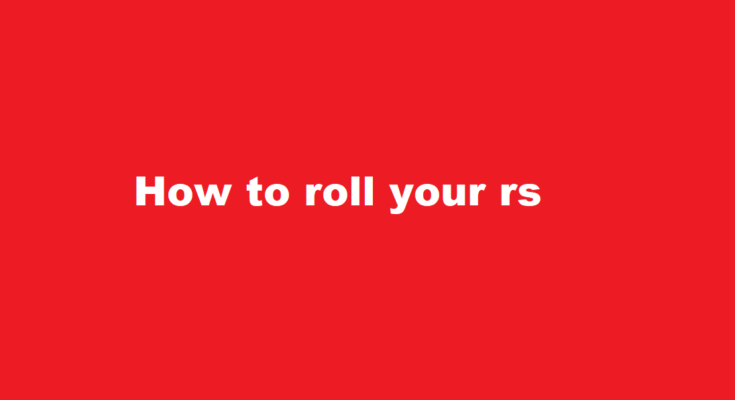Rolling your “R”s is a fascinating and distinctive linguistic skill that adds a unique flair to your speech. It’s a sound commonly found in various languages, including Spanish, Italian, and Scottish Gaelic. Whether you’re trying to master it for language learning or simply want to impress your friends, learning how to roll your “R”s can be a fun and rewarding endeavour. In this article, we’ll explore the techniques and exercises that can help you achieve this elusive skill.
Understanding the Rolled “R” Sound
Before diving into the techniques, let’s understand what the rolled “R” sound is. In phonetics, it’s known as an alveolar tap or flap. It’s a sound produced by a rapid, repetitive movement of the tip of the tongue against the alveolar ridge, which is the bony ridge just behind your upper front teeth. This creates a distinctive, rolling or tapping sound that’s quite different from the standard English “R” sound.
Techniques to Roll Your “R”s
- Tongue Position Start by placing the tip of your tongue against the alveolar ridge, just behind your upper front teeth. The back of your tongue should be slightly raised, creating a small space for the air to flow through.
- Air Pressure To create the rolling sound, you need to manipulate air pressure with your tongue. Build up a small amount of air pressure behind the tongue by constricting the space between your tongue and the alveolar ridge.
- Flap Your Tongue The key to rolling your “R”s is to rapidly flap your tongue against the alveolar ridge. It’s like a quick, controlled strike of your tongue against this spot. Imagine your tongue dancing or fluttering against the ridge.
- Practice Softly Initially, try to roll your “R”s softly. Don’t exert too much force; instead, focus on the rapid movement of your tongue. You’ll find that with practice, you can gradually increase the intensity and volume.
- Mirror or Record Yourself Use a mirror or recording device to observe your tongue’s position and movement. This visual feedback can help you make necessary adjustments.
- Exaggerate the Sound Start by exaggerating the rolling sound. This can help you get a feel for the movement required. Over time, you can refine it to sound more natural.
Exercises to Develop the Skill
- Repetition Like any skill, practice makes perfect. Set aside time each day to practise rolling your “R”s. Consistent effort is key to mastering this skill.
- Tongue Twisters Tongue twisters that feature the rolled “R” sound are excellent for practice. Start with simple ones and progress to more challenging ones as you improve.
- Mimic Native Speakers Listening to native speakers of languages with rolled “R”s can be immensely helpful. Try to imitate their pronunciation and rhythm.
- Vocal Warm-Ups Incorporate rolled “R” sounds into your vocal warm-up routine. This will help loosen your tongue and make it more flexible for rolling.
- Music and Songs Sing along to songs that have rolled “R” sounds. Music can be an enjoyable way to practise pronunciation.
- Language Courses If you’re learning a language that uses the rolled “R,” consider enrolling in a language course with a skilled instructor who can provide guidance and feedback.
Overcoming Challenges
Rolling your “R”s can be a challenging skill to acquire, and not everyone may find it easy. Here are some common challenges and tips to overcome them
- Tongue Tension If your tongue feels tense or stiff, try relaxing it. Tension can hinder the rapid movement required for rolling your “R”s.
- Lack of Progress If you’re not making progress, be patient. Learning to roll your “R”s can take time, and everyone progresses at their own pace.
- Inconsistent Results Some days, you may find it easier to roll your “R”s than others. This is normal. Keep practising regularly to improve consistency.
- Frustration Don’t get discouraged if you don’t master it immediately. Learning any new skill takes time and effort. Stay positive and persistent.
FREQUENTLY ASKED QUESTIONS
Is it Genetic to roll your R’s?
To many native English speakers, the rolled R is notoriously hard to pronounce since there isn’t an equivalent in the English language. The biggest myth around this topic is the ability of rolling your R’s genetics. In fact, alveolar trill is a skill that can be acquired through practising.
At what age can kids roll their rs?
Rs are the most difficult letter to pronounce, and often kids won’t fully develop the ability until the age of seven.
What words do you roll your Rs with?
If you’re having trouble producing ‘rrrrr’, try ‘arrrr’, ‘errrr’ or ‘drrrr’ instead. You can also use some example words like “carro” or “vorrei” in Spanish. This will help your tongue get more comfortable and increase the likelihood of producing the sound.
In Conclusion
Rolling your “R”s is a skill that adds a unique dimension to your speech and can be a valuable asset for language learners and enthusiasts. While it may take time and practice to master, with dedication and the right techniques, anyone can learn how to roll their “R”s. So, embark on this linguistic journey, practice regularly, and soon you’ll be rolling your “R”s like a pro, impressing others with your newfound ability. Happy rolling!
Read Also : Crafting Protection How to Make a Shield in Minecraft



